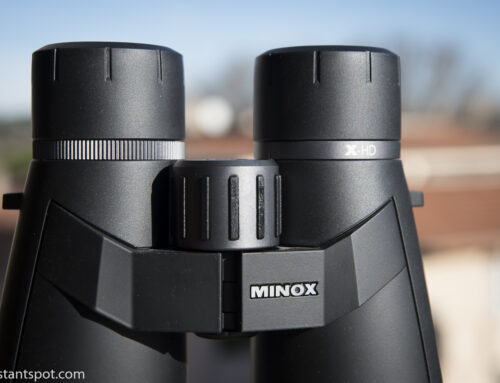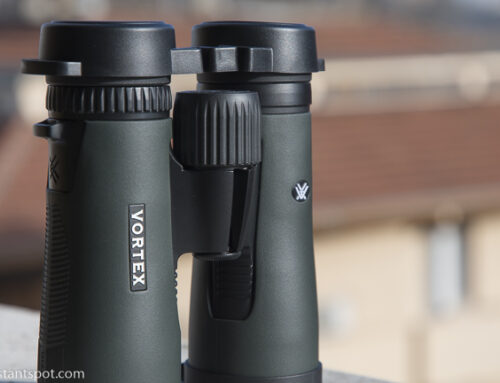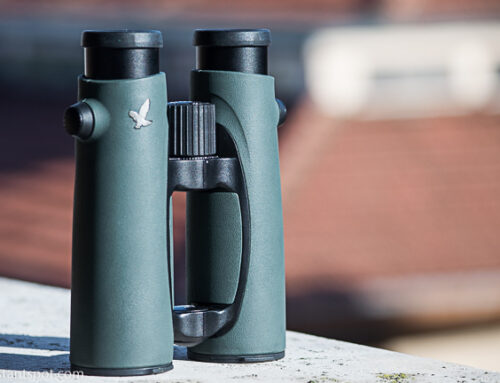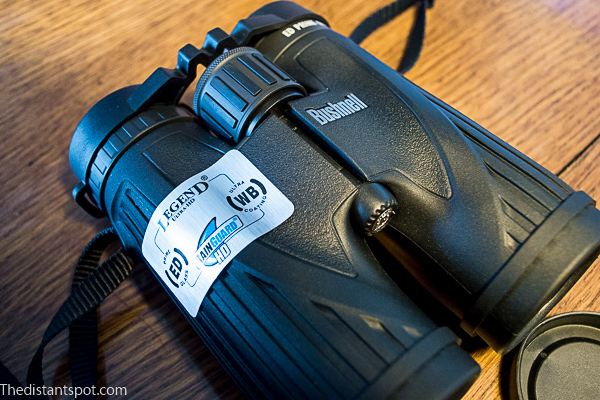Bushnell Legend Ultra HD 8×42
I purchased these binoculars for the observation of stars and sky objects but, after having tried them for a few days, I decided to return them.
They are certainly very bright binoculars, also thanks to the BaK-4 glass roof prisms and despite a diameter of only 42 mm. I found the grip comfortable, even though the gel pads that they have “under the skin”, at the point where the thumbs support it, gave me a rather strange feeling: maybe they weren’t big enough for my hands.
I fought a lot with removable eyepieces and shells to avoid the blackouts seen at the beginning (the darkening of the image that occurs when the set of lenses – not only in binoculars – does not tolerate that the eye is not positioned perfectly at the center, but looks from a more or less lateral point, or too close): I could not understand if the right position for me was with the shells lowered and the binoculars resting on the eyebrows, or with the shells extracted. I know, though, that I have never completely solved it.
The control of chromatic aberration is excellent. I could just make it out towards the edge of the image.
Unfortunately, some of their main qualities are also those that convinced me to return it: I refer to the field of view and its clarity. The field of view, with 8 real degrees and an apparent diameter of 64 degrees, is really large. Looking through the eyepieces, it seems to be able to see all that is in front of you in one go. Unfortunately, however, such a large field invites the eye to wander through the image and here the problems begin, because much of it is not really usable.
The sharpness is excellent in the center of the field: the images are engraved, contrasted and show a very good detail. Too bad that what the Anglo-Saxons call “sweet spot”, which we could call “maximum yield point”, is really such: a point. The maximum of the yield, in fact, is obtained by positioning the framed object exactly in that point. Neither above nor right of it, but exactly there. Looking at the full moon, the problem was immediately obvious. Some minor craters, of which the rim could be distinguished well, began to lose detail as soon as the frame moved. Furthermore, it must be added that, at least in the copy that I had received, this point was not located at the center of the image, as would have been logical to expect, but a little higher. I don’t know if it was a specific problem of my binoculars or a constant, in any case it has done nothing but worsen the experience of use. For freehand use, in fact, this means having to constantly move the binoculars trying to perfectly center the object you want to observe in that one point of perfect sharpness that is “somewhere above the center”. In the observation of an extended object, therefore, the point of maximum yield risks being smaller than the object, so that the deterioration of the image can already be appreciated at the edges of the object with respect to its center.
I would like to say that the distortion at the edges of the image was annoying only in astronomical use, but I would lie. The vision of a tree 20 meters away from my balcony was the first to show the problem. The top of the tree, centered in the binoculars sweet spot, was perfect; the image, however, degraded very quickly by shifting the gaze towards the edges: a good 20-25% of the image resembled a freshly painted picture on which someone had passed a finger spreading the painting in a circular motion. In astronomical use this defect led to having stars that, at the edges of the image, resembled startrails (have you ever seen any of those long exposure night photos in which the polar star is still, and all the other stars trace trails all around ?). With fairly bright stars, the phenomenon became really annoying and able to distract a lot from the observation. This aspect was already very evident when looking at the sky from a city balcony: I can’t imagine how it could be if seen under a mountain sky, where it is practically impossible not to have stars at the edges of the image.
Anyway, since these binoculars frame a large field, you could think that the correct part of it, despite being only the central one (central!) is still of good size: it is not true. Pointing two different binoculars towards the same object, it was clear that this part is really reduced.
As for the diffraction produced by binoculars with roof prisms in observing a strong light source (the so-called “spikes”), the Bushnell showed no particular problems either on the streetlights or on the Moon. Small spikes were present, of weak intensity, which I had only noticed by comparing them with another pair of binoculars. Doing the test inside home, with a led bulb positioned 3-4 meters away, the “spikes” became more visible, but I think I can say that they would hardly have been annoying in real use.
The image turned a little towards the yellow, which was particularly evident on the white light lamps; on the stars, however, I did not perceive this effect.
It may be that it is a pair of binoculars suitable for birdwatching, as I read on more than one site, but for the use I wanted to make of them I preferred to buy something else. In any case, I doubt that a pair of binoculars like this one, excellent in the middle and bad in the rest, could be preferable to an instrument evenly balanced across the whole field of view and, perhaps, with a decidedly lower price. It surely is possible to find such kind of binoculars (did I mention the Nikon Prostaff 7S 8×30?).
Bushnell Legend Ultra HD 8×42
I purchased these binoculars for the observation of stars and sky objects but, after having tried them for a few days, I decided to return them.
They are certainly very bright binoculars, also thanks to the BaK-4 glass roof prisms and despite a diameter of only 42 mm. I found the grip comfortable, even though the gel pads that they have “under the skin”, at the point where the thumbs support it, gave me a rather strange feeling: maybe they weren’t big enough for my hands.
I fought a lot with removable eyepieces and shells to avoid the blackouts seen at the beginning (the darkening of the image that occurs when the set of lenses – not only in binoculars – does not tolerate that the eye is not positioned perfectly at the center, but looks from a more or less lateral point, or too close): I could not understand if the right position for me was with the shells lowered and the binoculars resting on the eyebrows, or with the shells extracted. I know, though, that I have never completely solved it.
The control of chromatic aberration is excellent. I could just make it out towards the edge of the image.
Unfortunately, some of their main qualities are also those that convinced me to return it: I refer to the field of view and its clarity. The field of view, with 8 real degrees and an apparent diameter of 64 degrees, is really large. Looking through the eyepieces, it seems to be able to see all that is in front of you in one go. Unfortunately, however, such a large field invites the eye to wander through the image and here the problems begin, because much of it is not really usable.
The sharpness is excellent in the center of the field: the images are engraved, contrasted and show a very good detail. Too bad that what the Anglo-Saxons call “sweet spot”, which we could call “maximum yield point”, is really such: a point. The maximum of the yield, in fact, is obtained by positioning the framed object exactly in that point. Neither above nor right of it, but exactly there. Looking at the full moon, the problem was immediately obvious. Some minor craters, of which the rim could be distinguished well, began to lose detail as soon as the frame moved. Furthermore, it must be added that, at least in the copy that I had received, this point was not located at the center of the image, as would have been logical to expect, but a little higher. I don’t know if it was a specific problem of my binoculars or a constant, in any case it has done nothing but worsen the experience of use. For freehand use, in fact, this means having to constantly move the binoculars trying to perfectly center the object you want to observe in that one point of perfect sharpness that is “somewhere above the center”. In the observation of an extended object, therefore, the point of maximum yield risks being smaller than the object, so that the deterioration of the image can already be appreciated at the edges of the object with respect to its center.
I would like to say that the distortion at the edges of the image was annoying only in astronomical use, but I would lie. The vision of a tree 20 meters away from my balcony was the first to show the problem. The top of the tree, centered in the binoculars sweet spot, was perfect; the image, however, degraded very quickly by shifting the gaze towards the edges: a good 20-25% of the image resembled a freshly painted picture on which someone had passed a finger spreading the painting in a circular motion. In astronomical use this defect led to having stars that, at the edges of the image, resembled startrails (have you ever seen any of those long exposure night photos in which the polar star is still, and all the other stars trace trails all around ?). With fairly bright stars, the phenomenon became really annoying and able to distract a lot from the observation. This aspect was already very evident when looking at the sky from a city balcony: I can’t imagine how it could be if seen under a mountain sky, where it is practically impossible not to have stars at the edges of the image.
Anyway, since these binoculars frame a large field, you could think that the correct part of it, despite being only the central one (central!) is still of good size: it is not true. Pointing two different binoculars towards the same object, it was clear that this part is really reduced.
As for the diffraction produced by binoculars with roof prisms in observing a strong light source (the so-called “spikes”), the Bushnell showed no particular problems either on the streetlights or on the Moon. Small spikes were present, of weak intensity, which I had only noticed by comparing them with another pair of binoculars. Doing the test inside home, with a led bulb positioned 3-4 meters away, the “spikes” became more visible, but I think I can say that they would hardly have been annoying in real use.
The image turned a little towards the yellow, which was particularly evident on the white light lamps; on the stars, however, I did not perceive this effect.
It may be that it is a pair of binoculars suitable for birdwatching, as I read on more than one site, but for the use I wanted to make of them I preferred to buy something else. In any case, I doubt that a pair of binoculars like this one, excellent in the middle and bad in the rest, could be preferable to an instrument evenly balanced across the whole field of view and, perhaps, with a decidedly lower price. It surely is possible to find such kind of binoculars (did I mention the Nikon Prostaff 7S 8×30?).





